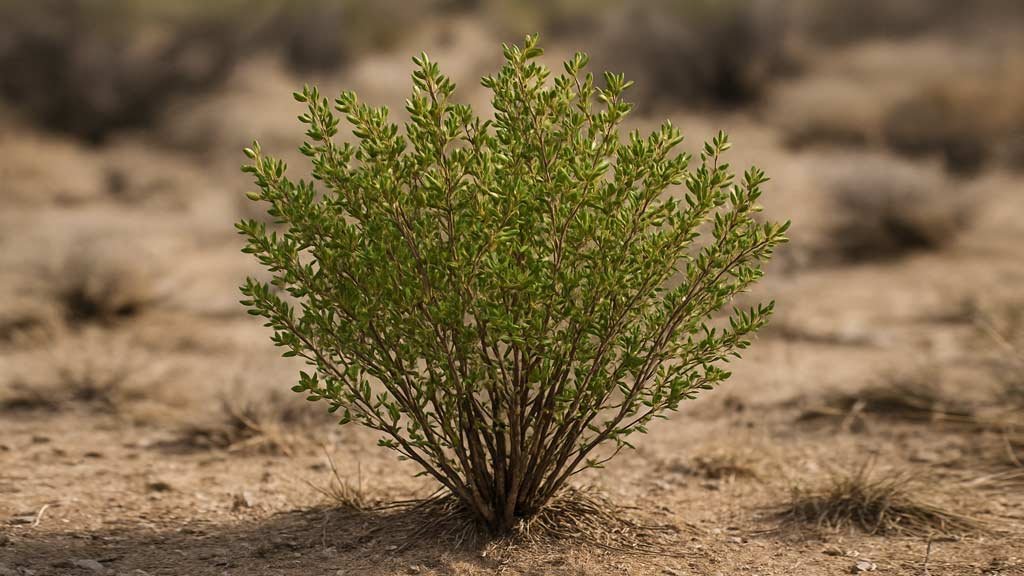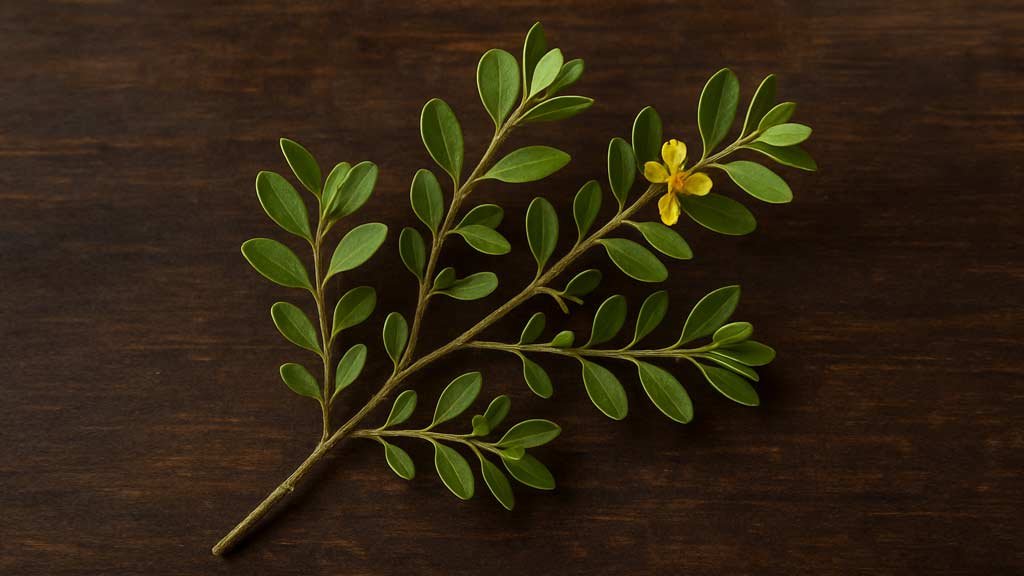The Essence of the Desert
Chaparral herb (Larrea tridentata), often called creosote bush, is a rugged desert plant that has survived the harsh landscapes of the American Southwest for centuries. Its resinous, aromatic leaves release a sharp, almost pine-like scent when crushed, evoking visions of sunbaked earth and windswept canyons. There’s something about that aroma—it’s earthy, slightly bitter, and somehow cleansing. Indigenous peoples have long revered it for its medicinal properties, particularly its detoxifying traditions.
Walking through a chaparral thicket, even today, it’s easy to understand why. The plant seems to whisper resilience and strength, surviving droughts, heat, and time.
Table of Contents
Botanical and Nutritional Profile
Chaparral is more than just a tough desert survivor; its leaves contain compounds that give it medicinal potential:
- Lignans and flavonoids: Provide antioxidant and anti-inflammatory effects
- Essential oils: Including nordihydroguaiaretic acid (NDGA), historically studied for its bioactive properties
- Tannins: Offer mild astringent effects and contribute to detoxification
These compounds interact in subtle ways, promoting wellness without the overpowering intensity of some modern supplements. NDGA, in particular, is a double-edged sword—powerful in small, controlled doses, but potentially toxic in excess. Respect for dosage is key.
Traditional Uses and Detox Practices
Indigenous peoples have long utilized chaparral for its perceived cleansing and protective properties:
- Internal cleansing: Brewed teas or decoctions used for general detoxification
- Topical applications: Poultices for skin conditions or minor wounds
- Spiritual rituals: The aromatic smoke of chaparral was sometimes used in purification ceremonies
Detox traditions often emphasized moderation and ritual: a small cup of chaparral tea could refresh the system, but excessive use was avoided.
Anecdotal Insights
I remember reading accounts of desert dwellers who carried chaparral leaves with them, steeping a few to drink after a particularly rich or heavy meal. They described a subtle “reset” sensation—a gentle lightness in the stomach, coupled with the crisp, resinous scent that seemed to lift the spirit. It’s subtle, but unmistakably present.
Antioxidant and Anti-Inflammatory Potential
Chaparral herb contains a range of antioxidant compounds, which can help neutralize free radicals and support overall cellular health. Flavonoids and lignans are particularly potent:
- Free radical scavenging: May reduce oxidative stress in tissues
- Anti-inflammatory effects: Can soothe mild inflammation in joints or skin
- Cellular support: Helps maintain tissue integrity under environmental stress
These benefits are more cumulative than immediate, which may explain why traditional users often consumed chaparral as a routine tonic rather than a one-time cure.
Digestive and Liver Support
Chaparral has historically been valued for digestive and liver support. Tannins and essential oils may stimulate bile production and support mild detoxification pathways in the liver. Users often reported:
- Improved digestion after meals
- A reduction in bloating or heaviness
- Enhanced sense of well-being after regular, moderate use
It’s gentle, a plant that works alongside your body rather than pushing it too hard.
Preparation Methods
Traditional preparations include:
- Teas: Steeping leaves in hot water for several minutes
- Decoctions: Simmering leaves longer for concentrated effects
- Topical washes: Infusions used to cleanse skin gently
Moderation is crucial. Chaparral is powerful; overuse, especially concentrated extracts, can stress the liver.
Skin Health and Topical Applications
Chaparral has been used topically for its astringent and anti-inflammatory properties:
- Minor rashes or irritation: Infused washes calm inflammation
- Wound care: Poultices reduce discomfort and promote cleanliness
- Antimicrobial potential: Some traditional accounts suggest cleansing effects on skin surfaces
The aromatic quality of the plant adds a sensory layer, providing a crisp, desert-fresh experience while promoting skin wellness.

Contemporary Research and Considerations
Modern research on chaparral has focused largely on its antioxidant and anti-inflammatory properties. NDGA, the key active compound, shows promise in lab studies but has raised concerns regarding liver toxicity in high doses.
Key points from research:
- NDGA demonstrates strong antioxidant capacity
- Anti-inflammatory effects may support joint and cellular health
- Excessive intake can stress the liver and kidneys
Safety is a theme in all modern discussions. Traditional users respected dosage limits, often consuming chaparral in small amounts over time rather than as concentrated extracts.
Culinary and Sensory Use
While chaparral is primarily medicinal, it can also be integrated into food or drink in subtle ways:
- Herbal teas: Lightly flavored with honey or citrus
- Infusions for cooking: Small amounts added to soups or broths for earthy aroma
- Smoky flavoring: Traditionally, dried leaves added a resinous note to ceremonial or festive foods
The flavor is distinctive—resinous, earthy, with a hint of bitterness—but used sparingly, it enhances rather than dominates.
Integrating Chaparral into Daily Life
Incorporating chaparral safely and effectively means respecting its strength:
- Routine tonic: Small cups of tea a few times per week
- Topical care: Occasional washes or poultices for minor irritations
- Mindful preparation: Avoid over-concentration and respect traditional measures
It’s a plant that rewards patience. Its benefits accumulate quietly, noticeable only after consistent, respectful use.
Combining with Other Herbs
Chaparral can be combined with complementary herbs for mild detoxification or anti-inflammatory synergy:
- Red clover: Supports liver function and detox pathways
- Dandelion root: Gentle digestive support
- Peppermint or Yerba Buena: Balances flavor and adds digestive soothing
These combinations were often used traditionally to create multi-faceted tonics, emphasizing balance rather than force.
Safety and Precautions
Chaparral herb is powerful, and caution is necessary:
- Avoid concentrated extracts without professional guidance
- Not recommended for pregnant or breastfeeding women
- Use moderate amounts in teas or topical applications
- Monitor for any adverse effects, particularly liver-related symptoms
Respecting the plant ensures safe and effective use while honoring centuries of traditional knowledge.
Lifestyle and Anecdotal Integration
I once read an account of desert dwellers who chewed chaparral leaves during long journeys. They reported a sense of mental clarity and physical lightness, describing it as a “reset” for body and mind. It’s this quiet, cumulative effect—subtle, not immediate—that makes chaparral so intriguing.
Including chaparral in daily rituals, whether through tea, mild infusions, or occasional topical use, transforms it from a mere plant into a companion in wellness.
Summary of Benefits
- Detox and cleansing: Supports liver and digestive health
- Antioxidant support: Flavonoids and lignans neutralize free radicals
- Anti-inflammatory effects: Calm minor skin and joint discomfort
- Topical care: Poultices and washes for skin health
- Aromatic and sensory benefits: Crisp, resinous scent evokes the desert
Chaparral combines history, resilience, and subtle efficacy—a reminder that traditional wisdom often aligns with modern understanding when approached with care.
Final Thoughts
Chaparral herb embodies the spirit of the desert: resilient, aromatic, and quietly powerful. Its detox traditions, antioxidant properties, and gentle support for digestion and skin health make it a fascinating plant. Using it responsibly honors both the plant and the wisdom of those who have relied on it for generations. A cup of chaparral tea, a subtle topical wash, or even the scent of crushed leaves can be a small, meaningful ritual of wellness, connecting you to the desert and centuries of herbal knowledge.
Article Sources
At AncientHerbsWisdom, our content relies on reputable sources, including peer-reviewed studies, to substantiate the information presented in our articles. Our primary objective is to ensure our content is thoroughly fact-checked, maintaining a commitment to accuracy, reliability, and trustworthiness.
- LiverTox. (2022, May 25). Chaparral. In LiverTox: Clinical and Research Information on Drug-Induced Liver Injury. National Institute of Diabetes and Digestive and Kidney Diseases. https://www.ncbi.nlm.nih.gov/books/NBK548355/
- Healthline. (2020, March 2). Chaparral Herb: Benefits, Uses, and Side Effects. https://www.healthline.com/nutrition/chaparral-herb
- Memorial Sloan Kettering Cancer Center. (2021, February 11). Chaparral. https://www.mskcc.org/cancer-care/integrative-medicine/herbs/chaparral
- Drugs.com. (2025, July 14). Chaparral Uses, Benefits & Dosage. https://www.drugs.com/npc/chaparral.html
- PeaceHealth. (n.d.). Chaparral – Health Information Library. https://www.peacehealth.org/medical-topics/id/hn-2067001
- Cancer Research UK. (n.d.). Chaparral | Complementary and alternative therapy. https://www.cancerresearchuk.org/about-cancer/treatment/complementary-alternative-therapies/individual-therapies/chaparral
- 7Song. (n.d.). Plant Medicine Notes-Chaparral (Larrea Tridentata). https://7song.com/plant-medicine-notes-chaparral-larrea-tridentata/
- University of Texas at El Paso. (n.d.). Creosote Bush, Chaparral. https://www.utep.edu/herbal-safety/herbal-facts/herbal%20facts%20sheet/creosote-bush-chaparral.html

